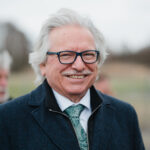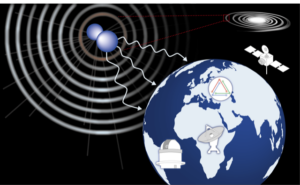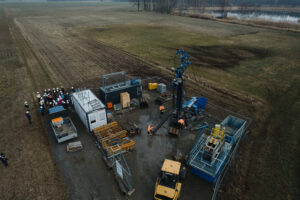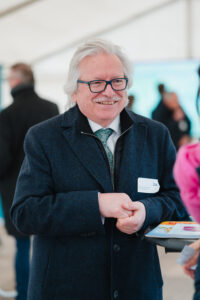
A new research center for Astrophysics in Germany
Interview with Günther Hasinger, designated director of DZA
At the end of September, the German BMBF announced its decision that the German Center for Astrophysics (DZA) had been selected as a new research center in Lusatia. In a multi-stage procedure, this proposal, submitted by scientists from astronomy and astroparticle physics led by Günther Hasinger, prevailed over its competitors.
Congratulations to you and your whole team! This success will have great impact on the development of astronomy and astroparticle physics, not only in Germany. Can you explain the scientific aim and the mission of this new research center?

Mulitmessenger physics at the German Center for Astrophysics. Credits: DESY
The DZA has three main pillars: research, technology and digitalization. The research in principle will cover several fields of astrophysics in synergy, but in the beginning, we concentrate on areas with high innovation potential in technology and digitization: radio and gravitational wave astronomy. Both areas have exciting new developments and instruments that provide huge opportunities, especially in opening innovation potential and collaboration with industry. In particular radio astronomy will produce (among) the largest rate and volume of data in any kind of science, pre-empting future requirements across society and science. Our research mission thus has a large societal impact.
The competition “Wissen.schafft.Perspektiven” (Knowledge.creates.perspectives) is intended to provide regional structural support. How was the DZA able to convince here?
We start with strengthening the positive elements already existing in the region: its location in the very center of Europe with close connections to the Polish and Czech republic; the surrounding Universities and colleges with a scientific and technological focus; the breadth and depth of surrounding industries as partners in technology development and digitization; the local people firmly rooted in the region with great openness and curiosity for new development; and last not least, the unique seismographic conditions in granite rock: the Treasure of Lusatia.
One element for our success is the excellent team team spirit we were able to demonstrate throughout the preparation process in the whole region. Our strength is the leading competence and experience from research and development through planning to the implementation of major projects and operation. We do not have to build national and international networks. We will bring them with us.

Drilling site in Cunnewitz. Credits: DESY/ Paul Glaser
How can science profit the chosen location?
We want to create a national lighthouse with an international appeal with a research mission of high societal impact. The unique combination of research and development in digitization, sensor technology and materials research provide jobs with a long-term future in many areas and a magnet for business and institutions, support for start-ups and spin-offs, transfer. This requires new education for a whole generation from day care through vocational training to university and gives prospects for young people in the region, securing the need for skilled workers. We attract people and prevent brain drain.
How will this research center influence astronomy and astroparticle physics in Germany and in Europe?
Germany is making outstanding contributions to astronomical research, e.g. exemplified by the Nobel Prize for the Black Hole in our Milky Way. The European Southern Observatory (ESO) and European Space Agency (ESA), organized through state treaties, allow German astrophysics to play leading roles. However, for future large international astrophysics projects the situation is different. The Square Kilometre Array (SKA) radio observatory is e.g. planned jointly by various nations, the Einstein Telescope, the Vera Rubin Observatory, and the European Solar Telescope all require new national structures that are not existing in Germany today. SKA is calling for regional data centres. The Einstein Telescope is looking for partners in Europe to set up large test and development centres for gravitational wave interferometers. The possibilities for German industry to participate in such tenders require institutional commitment. The DZA therefore has an important national role in astrophysics and astroparticle physics.
What is the timeline of this project?
The project starts with a three-year build-up phase, anchored at the Technical University Dresden, where the formal legal foundation process is prepared and all the major plans for construction, digitization and technology development are prepared. Already during this phase we want to employ several high-level leadership positions in cooperation with the TU Dresden.
The formal foundation procedure is expected for early 2026, when a roughly 10-year ramp-up and construction phase begins. The final center will host about 1000 employees in three institutes, for astrophysics, technology and digitization at the campus in Görlitz and a Low Seismic underground lab in the Lusatia granite block between Bautzen, Hoyerswerda and Kamenz.

Günther Hasinger, Credits: DESY/ Paul Glaser
Günther Hasinger, currently director of Science at ESA and Head of ESAC, was born in Oberammergau, Germany, in 1954. Between 1994 and 2001 he has been a professor at the University of Potsdam and served as director of the Astrophysical Institute Potsdam. In 2001 he was appointed as the director High Energy Group at the Max Planck Institute for Extraterrestrial Physics (MPE). In 2008 he became scientific director at the Max Planck Institute for Plasma Physics (IPP) which he left in 2011 to serve as the director of the Institute for Astronomy (IfA) of the University of Hawaii at Manoa until he moved to ESA in 2017. He has held the chair of the Council of German Observatories (RDS) and served as the president of the International Astronomical Union Division on Space and High Energy Astrophysics. Günther Hasinger played a key role in the operation of X-ray satellites, the development of future observatories or the discoveries of the cosmic X-ray background radiation. He received numerous awards for his scientific achievements, including the Leibniz Prize of the Deutsche Forschungsgemeinschaft, the international Committee on Space Research (COSPAR) Award and the Wilhelm Förster Prize for public dissemination of science. He is a member of the Academia Europea, the Berlin-Brandenburg Academy of Sciences, and Leopoldina (the German National Academy of Sciences), and an external member of the Austrian Academy of Sciences.
Further information
- Deutsches Zentrum für Astrophysik: https://www.deutscheszentrumastrophysik.de/de



